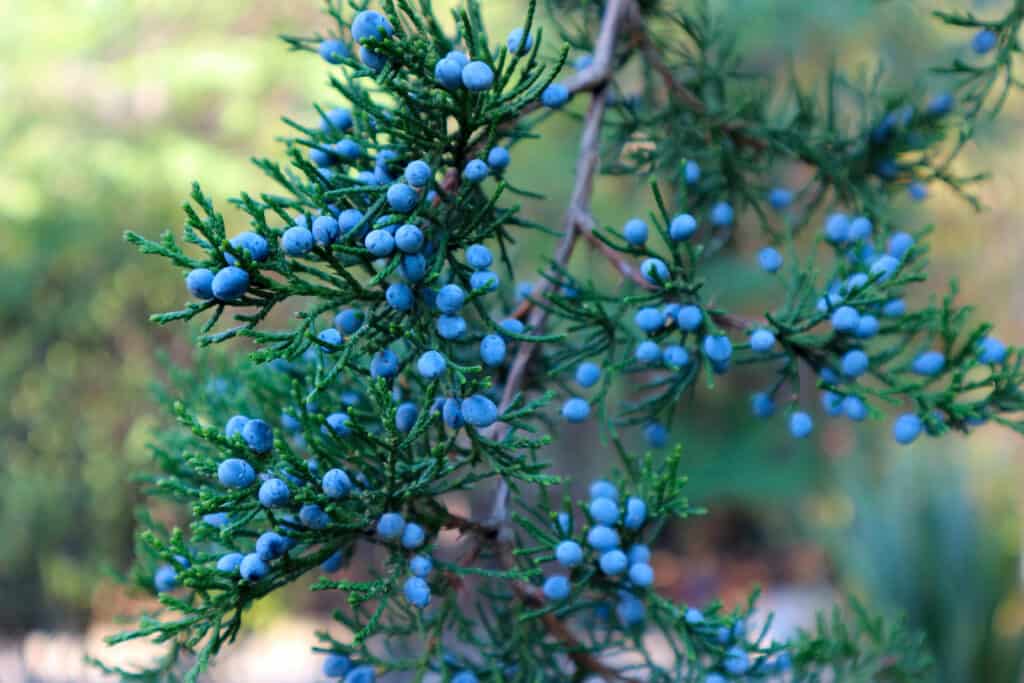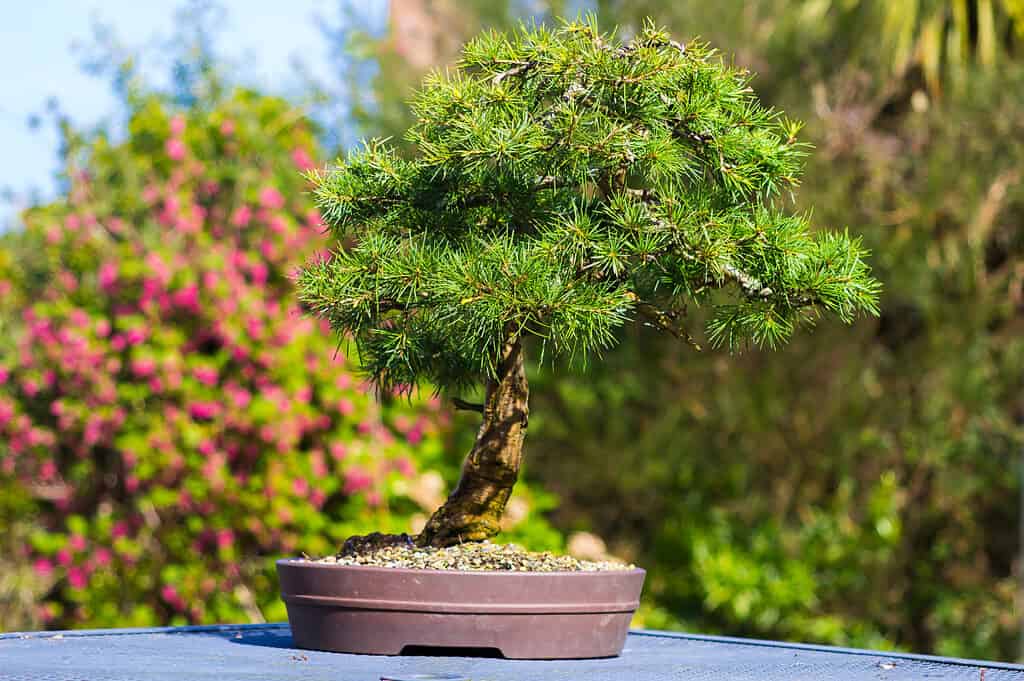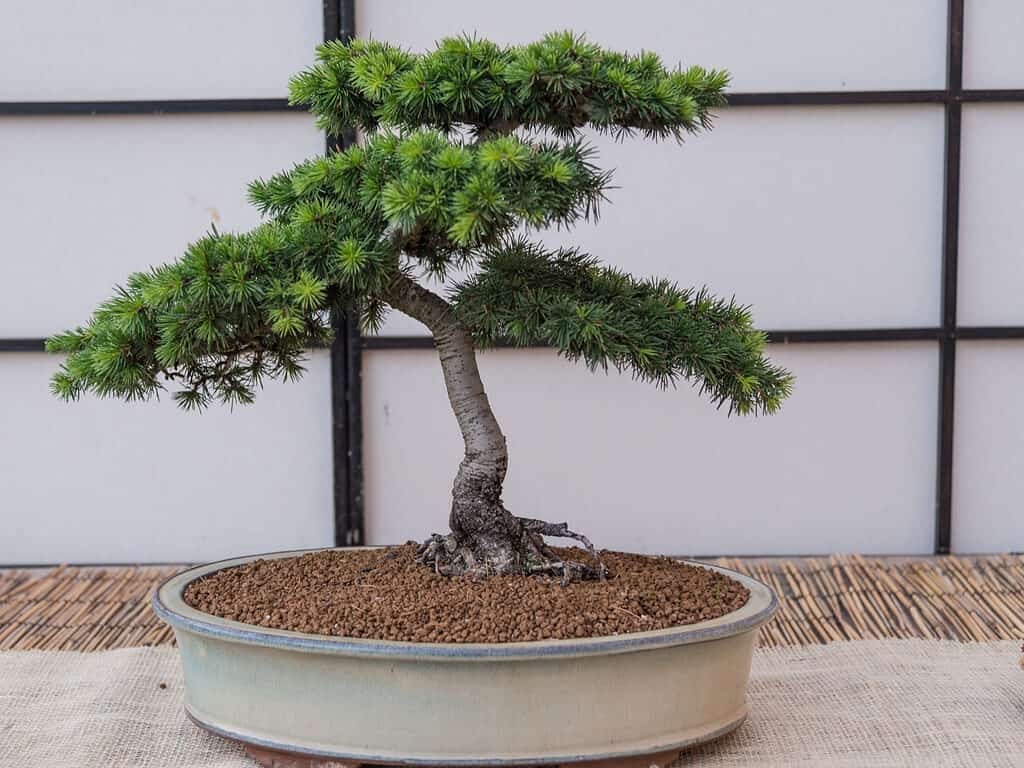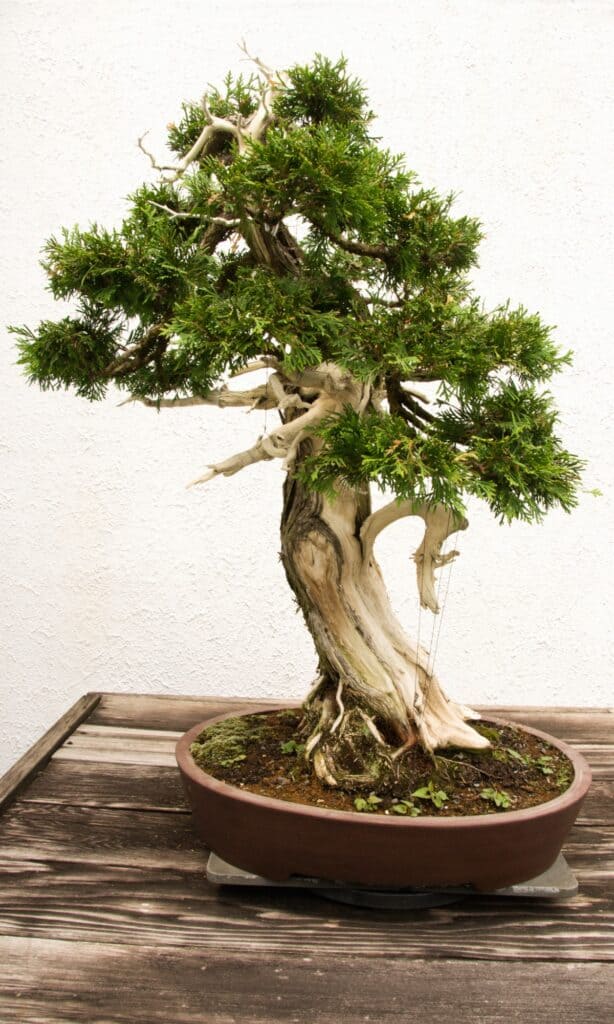Similar and care to other conifers, cedar Bonsai trees are relatively underutilized in the Bonsai world. However, these striking trees produce delicate green needles and textured bark. They pair well with other conifers in a forest-style setting, or you can shape your cedar Bonsai tree into whatever style you like.
No matter how you plan on displaying your cedar Bonsai tree, there are a number of things to learn in terms of its care and placement requirements. Here’s your guide for all of the different types of cedar trees typically used in a Bonsai tree format as well as how you can best care for one in your own home!

Your cedar Bonsai tree will thrive in bright sunlight, so long as it receives at least six hours per day.
©Jack.Q/Shutterstock.com
| Cedar Bonsai Tree Facts | |
|---|---|
| Botanical Name | Cedrus |
| Common Types | Cedrus libani, Cedrus brevifolia, Cedrus deodara, Cedrus atlantica |
| Sunlight | Full, direct sunlight |
| Soil | Prefers more acidic soil than the average Bonsai tree; add organic matter to a Bonsai potting mix or create your own using rocks and clay |
| Water | Allow soil to dry between waterings, especially during winter; cedar trees prefer to dry out! |
| For Beginners? | Intermediate; may be difficult to shape at first |
| Indoors or Outdoors? | Outdoors only; protect young trees especially well during winter |
| Pairs Well With… | Combine with other conifers to create a forest, or add moss to your powerful cedar tree! |
Common Types of Cedar Bonsai Trees
While there are a number of different cultivars and subspecies of cedar trees, there are four primary species used for Bonsai tree cultivation. Members of the cedrus genus, cedar trees can be found in the Himalayas and in the Mediterranean. Choosing a type that works well for your local climate is a good idea, given the fact that your cedar Bonsai tree will live outdoors.
Let’s talk about some of the most common types of cedar Bonsai trees now.
True Cedars vs False Cedars

Juniperus virginiana (virginian juniper) or Eastern Red Cedar Tree foliage and seeds. Blue berries of virginian juniper. Blur lights and bokeh effect
©iStock.com/Lyudmila Chetvertnykh
It’s important to note that there are a number of different tree species also referred to as cedar trees. However, besides the four species listed below, all others are considered false cedars or members of other tree genuses. This isn’t to say that you can’t make false cedar trees into Bonsai trees, but they aren’t technically members of the cedrus genus.
Some common false cedar trees include the western red cedar and the eastern red cedar. There are also some tree species found only in the Pacific Northwest. All of these trees have an aromatic bark that is often associated with cedar trees, likely leading to these common misclassifications and confusion.
Let’s take a closer look at the true cedar tree species now!
Atlas Cedar

Most Atlas cedar trees work well as Bonsai specimens.
©Irina Mos/Shutterstock.com
Native to Morocco, specifically the Atlas Mountains, atlas cedar trees make beautiful Bonsai trees because of their dark green foliage. In their endemic habitat, atlas cedar trees are surrounded by a number of other unique plants and animals, only found in the Atlas Mountains.
Lebanon Cedar

Another warmer-weather cedar has to be the Lebanon cedar Bonsai tree.
©Mick Harper/Shutterstock.com
Widely cultivated as an ornamental tree in Lebanon and Turkey, the Lebanon cedar works well as a Bonsai tree given its smooth bark and gray foliage. The deadwood on this particular Bonsai tree species is beautiful and fairly easy to craft.
Cyprus Cedar

You may be tempted to bring your cedar Bonsai tree inside during particularly frigid months of the year, but this will likely harm your tree more than help.
©Bernd Schmidt/Shutterstock.com
Just like the atlas cedar, the Cyprus cedar is only found in one particular mountain range located in Cyprus. It can handle colder temperatures than the average cedar tree, with blue-green needles and white-gray bark.
Deodar Cedar
Also known as a Himalayan cedar, the Deodar cedar has a number of cultivars and varieties that are ideal for Bonsai tree cultivation. The needles on this particular cedar specimen are longer than average. This may or may not suit your Bonsai tree design.
Caring for Your Cedar Bonsai Tree

You may want to shape your cedar Bonsai tree all at once, but doing so could result in severe harm or even death to your specimen.
©Federico Magonio/Shutterstock.com
It’s important to only choose to care for a cedar Bonsai tree if you live in a climate that supports their growth. These trees are best grown in temperate regions, outdoors, so long as temperatures average anywhere from 30 to 80 degrees Fahrenheit. You can always provide winter protection for your cedar Bonsai tree. This is a necessity for any new or young specimens.
You may be tempted to bring your cedar Bonsai tree inside during particularly frigid months of the year. However, this will likely harm your tree more than help. Cedar trees require the natural passage of time in order to grow properly, preferring to experience all four seasons outdoors. However, a greenhouse or other form of protection may help your cedar tree survive. Here are some other tips when it comes to caring for your cedar Bonsai tree.
Sunlight
Your cedar Bonsai tree will thrive in bright sunlight, so long as it receives at least six hours per day. However, depending on the season, you may need to move your cedar tree to a location that gets more light. It can be difficult finding a location that suits most Bonsai trees well, especially a tree like the cedar tree. You don’t want your cedar tree to get too hot during the summertime. But it also needs plenty of sunlight during its dormant winter months.
Soil Type
Many cedar tree varieties prefer acidic soil over other types of soil, so prioritizing this for your cedar Bonsai tree is a good idea. However, you should still use a traditional Bonsai potting mix to start with, adding acidic elements to it as you go. Incorporating lava rocks and different types of clay will also help support drainage and proper root health.
Water
Speaking of drainage and root health, your cedar Bonsai tree needs to be watered frequently. However, you need to make sure that the roots of your tree dry out in between waterings. Most cedar trees are native to Mediterranean environments or other locations that experience more drought on average. Keeping this in mind when you water your cedar Bonsai tree is a good idea, as less can indeed be more!
Placement
Besides choosing a location that gets plenty of sunlight, you should make sure that your cedar tree is protected from winds and wind chill. Your young trees are especially vulnerable to windy conditions and winter weather. Keep this in mind when choosing a place for your tree. While it can be difficult to find a place that works well for any Bonsai tree, keep in mind that the more you move it, the more problems you may run into. Trees are incapable of moving in their natural environment, so it can be stressful to constantly relocate a Bonsai tree!
Pruning Your Cedar Bonsai Tree

The good news is, if you happen to mess up while pruning your cedar Bonsai tree, they produce beautiful and elegant deadwood, so keep this in mind as you plan.
©gurb101088/Shutterstock.com
Once you know how to properly prune your cedar Bonsai tree, they are fairly easy to shape and maintain. It’s important to note that cedar trees take more time than the average tree to heal any wounds or injuries to them. You may want to shape your cedar Bonsai tree all at once, but doing so could result in severe harm or even death to your specimen. Taking it slow is the best way to shape any Bonsai tree, especially cedar trees!
It’s best to remove any new growth from your tree as it occurs, likely throughout the spring and summertime. Pinching new branches is less stressful than using shears or scissors. Trimming needles on their own will result in bald branches, incapable of growing more foliage or twigs. The good news is, if you happen to mess up while pruning your cedar Bonsai tree, they produce beautiful and elegant deadwood, so keep this in mind as you plan. You may end up with something even more beautiful than you expected!
Recommended Cedar Bonsai Tree Styles
Unlike other Bonsai tree varieties, cedar Bonsai trees can be shaped into just about any style. Incorporating cedar trees into a forest with other conifers is always an attractive option, or you can train your single cedar Bonsai tree into a cascade or semi-cascade style. The strong and narrow trunks of most cedar tree varieties may lend well to a slanted or formal style of Bonsai tree cultivation.
Propagating Your Cedar Bonsai Tree
One of the main reasons why cedar Bonsai trees may be so rare is that they are difficult to propagate from cuttings. Most Bonsai tree cultivators have success when growing cedar Bonsai trees from seed. These seeds will need a certain amount of time in cold storage or cold stratification processes before being planted.
While growing a Bonsai tree from seed will take significantly longer than cultivating an already-established plant, it may prove even more worthwhile and rewarding to do so!
Common Problems with Cedar Bonsai Trees

Some cedar species need partial shade in order to thrive, though ample sunlight is ideal for faster growth.
©iStock.com/LCBallard
Besides being difficult to propagate from cuttings, Cedar Bonsai trees also get fussy depending on the amount of sunlight they are receiving. Some cedar species need partial shade in order to thrive, though ample sunlight is ideal for faster growth. Many Bonsai tree artists grow tired of their cedar trees given the fact that they are indeed slow-growing, even more so than the average Bonsai tree!
Another common problem to keep in mind when raising a cedar Bonsai tree is the fact that they may need more protection in winter than you think. Some cedar Bonsai trees grow indoors during the winter with some success, but this is rare and likely to bring more pests and problems than you want.
Speaking of pests, you may want to invest in a cedar insecticide for your Bonsai tree. Cedar trees can be plagued by the following diseases and insects:
- Aphids
- Spider mites
- Root rot
- Blight fungal infections
- Foliage fungal infections
While relatively rare in the grand scheme of Bonsai tree growing and cultivation, cedar Bonsai trees make beautiful specimens if cared for correctly. While these Bonsai trees aren’t ideal for beginners, cedar trees bring elegance and maturity to any Bonsai tree display, no matter the season and no matter how it is styled!
The photo featured at the top of this post is © Mick Harper/Shutterstock.com
Thank you for reading! Have some feedback for us? Contact the AZ Animals editorial team.






